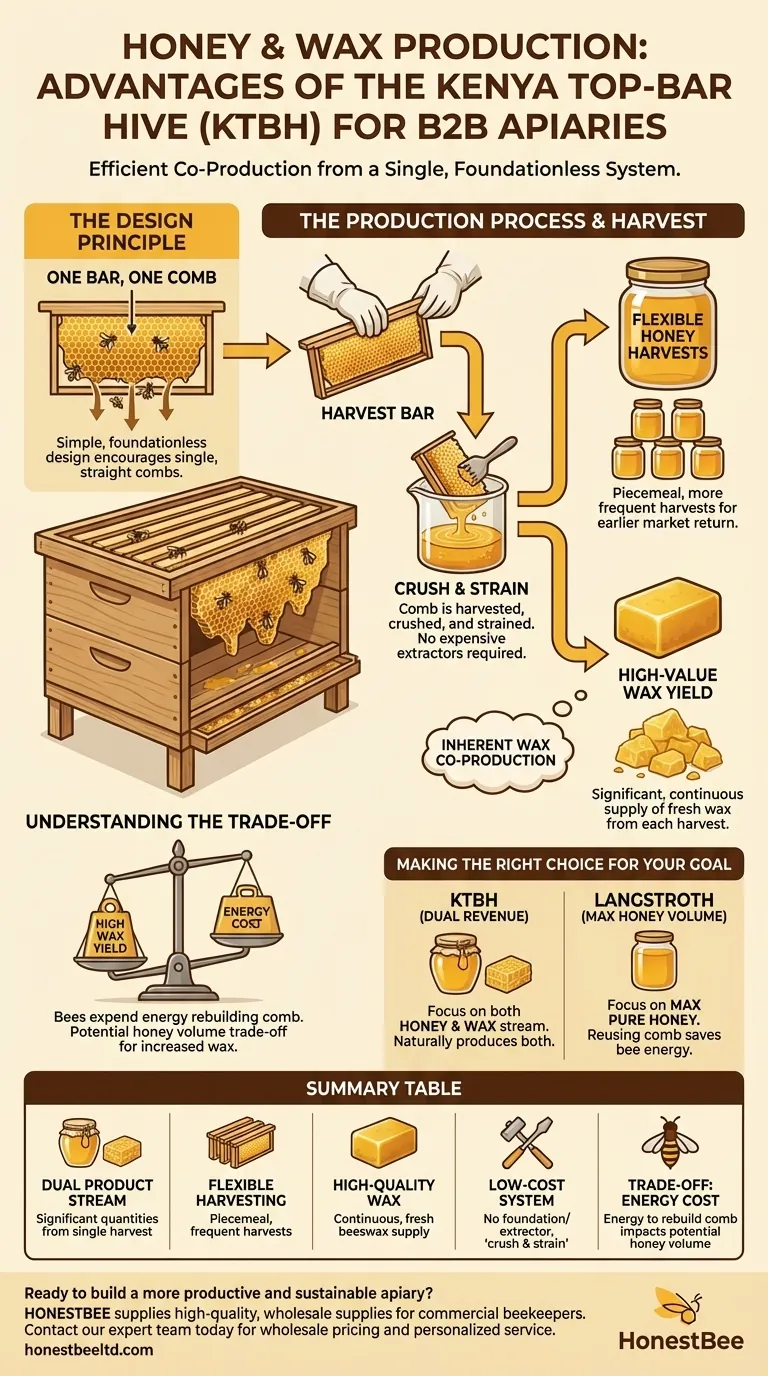In terms of production, the Kenya Top-Bar Hive (KTBH) offers a distinct advantage by generating significant quantities of both honey and high-quality beeswax from a single harvest. Its design facilitates simpler, more frequent harvesting, which can allow beekeepers to bring honey to market earlier in the season. While honey yields are anecdotally comparable to other hive types, the KTBH's primary strength lies in its efficient co-production of valuable wax.
The core advantage of the KTBH is not necessarily producing more honey, but in how it fundamentally links the harvest of honey to the harvest of wax. This makes it an exceptionally efficient system for beekeepers who value both products.

The Design Principle Driving Production
The unique output of a KTBH stems directly from its simple, foundationless design. Understanding this connection is key to appreciating its benefits.
One Bar, One Comb
In a KTBH, bees build their comb directly downward from a series of wooden "top bars" that form the ceiling of the hive. The specific width of these bars encourages the bees to build a single, straight comb per bar, with no additional frames or foundation.
The "Crush and Strain" Harvest
To harvest honey, the beekeeper removes an entire bar laden with a full comb. This comb is then cut off the bar, crushed, and strained to separate the liquid honey from the solid beeswax. The process is straightforward and requires no expensive extraction equipment.
Inherent Wax Co-Production
Because the entire comb is harvested and processed, every honey harvest automatically yields a complete comb of pure beeswax. This creates a consistent and significant secondary product stream from the hive.
Understanding the KTBH's Production Advantages
This integrated system results in a different production profile compared to conventional frame-based hives like the Langstroth.
High-Value Wax Yield
The most significant advantage is the quantity of wax produced. In a Langstroth hive, wax foundation is often reused for years to speed up honey production. In a KTBH, the bees are constantly building new comb, resulting in a continuous and much larger supply of fresh wax for the beekeeper to sell or use.
Flexible Honey Harvests
The KTBH allows for piecemeal harvesting. A beekeeper can inspect the hive and choose to harvest just one or two ripe combs of honey at a time. This enables smaller, more frequent harvests throughout the season, providing an earlier return on investment.
Understanding the Trade-offs
No hive design is perfect for every situation. The KTBH's advantages in wax production come with specific trade-offs.
The Energy Cost of Wax
Bees expend a tremendous amount of energy to produce wax. Because KTBH bees must constantly rebuild harvested comb, some of the energy that might have gone toward foraging and making more honey is diverted into wax production. This is the fundamental trade-off for the high wax yield.
Destructive Harvest Method
The "crush and strain" method is inherently destructive to the comb. While this is what yields the wax, it means the bees must start from scratch after each harvest. This contrasts with frame-based hives where an extractor empties the honey while preserving the comb structure for reuse.
Making the Right Choice for Your Goal
Selecting a hive depends entirely on your objectives as a beekeeper.
- If your primary focus is a dual revenue stream from both honey and wax: The KTBH is an outstanding choice because its harvest process naturally produces both.
- If your primary focus is maximizing pure honey volume with the fastest turnaround: A Langstroth hive with an extractor may be more efficient, as reusing drawn comb saves the bees significant energy.
- If your primary focus is low-cost, natural beekeeping: The KTBH's simplicity and lack of required foundation or extractors make it a very accessible and popular option.
Ultimately, the Kenya Top-Bar Hive empowers beekeepers to efficiently produce two valuable products from a single, sustainable system.
Summary Table:
| Advantage | Description |
|---|---|
| Dual Product Stream | Harvests significant quantities of both honey and pure beeswax from a single comb. |
| Flexible Harvesting | Allows for piecemeal, more frequent harvests by removing individual top bars. |
| High-Quality Wax | Produces a continuous, large supply of fresh beeswax as bees constantly build new comb. |
| Low-Cost, Simple System | Requires no expensive foundation or extraction equipment; uses the 'crush and strain' method. |
| Trade-off: Energy Cost | Bees use energy to rebuild comb after each harvest, which can impact potential honey volume. |
Ready to build a more productive and sustainable apiary?
As a beekeeper focused on maximizing the value of your harvest, choosing the right equipment is crucial. The Kenya Top-Bar Hive is an excellent choice for generating dual revenue from honey and wax.
At HONESTBEE, we supply commercial apiaries and beekeeping equipment distributors with the high-quality, wholesale supplies needed to succeed. Whether you're expanding your KTBH operations or need reliable equipment for any hive system, we are your trusted partner.
Let's discuss how we can support your beekeeping business. Contact our expert team today for wholesale pricing and personalized service.
Visual Guide

Related Products
- Top Bar Beehive for Beekeeping Wholesales Kenya Top Bar Hive
- Long Langstroth Style Horizontal Top Bar Hive for Wholesale
- HONESTBEE Professional Long Handled Hive Tool with Precision Cutting Blade
- HONESTBEE Professional Multi-Functional Hive Tool with Ergonomic Wood Handle
- HONESTBEE Advanced Ergonomic Stainless Steel Hive Tool for Beekeeping
People Also Ask
- What are the benefits of a top bar hive? A Natural, Low-Impact Approach to Beekeeping
- Why are hive inspections easier with Top Bar Hives? Achieve a Calmer, Safer Approach to Beekeeping
- What are the advantages of harvesting honey from a top bar hive? Low-Cost, Simple Harvesting for Beekeepers
- What are the labor requirements for a KTBH vs. Langstroth hive? A Guide for Apiary Efficiency
- Which is better Kenya top bar hive or Langstroth? Choose the Right Hive for Your Goals



















